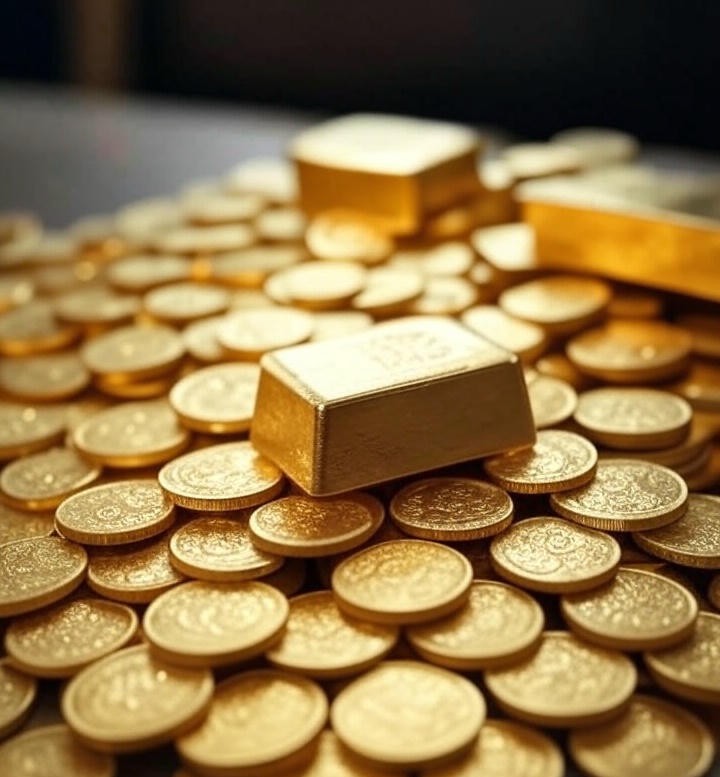Gold has always been a valuable metal. From ancient kingdoms to modern markets gold has been seen as a symbol of wealth and safety. But today it is much more than just a shiny metal. Gold plays a special role in the global economy especially when the world faces trouble. In times of crisis, war, inflation or financial instability gold becomes a “safe haven” a place where people and countries put their money to protect it from loss.

What Does “Safe Haven” Mean?
In finance a “safe haven” is something people invest in to protect their money during times of uncertainty. When the stock market falls when inflation rises or when war breaks out investors look for assets that don’t lose value. Gold is one of the most trusted safe haven assets. Others include government bonds and certain currencies like the U.S. dollar or Swiss franc.
But gold has a unique quality it is not tied to any one country, economy or company. It is a global asset and it holds value everywhere in the world.
Why Is Gold a Safe Haven?
1. Limited Supply:
Gold is rare. You can’t print more gold like you can with paper money. Because of its limited supply gold tends to keep its value over time.
2. Long History of Trust:
Gold has been used as money or a store of value for thousands of years. This trust makes people feel secure when they invest in it.
3. Inflation Protection:
When inflation rises, the value of money falls. But gold often rises in value when inflation goes up, which helps protect the investor’s money.
4. No Default Risk:
Gold is not a company or a government. It cannot go bankrupt or default on its payments. That makes it a very stable asset.
5. Geopolitical Stability:
In times of war, political tension, or natural disaster, gold usually goes up in value. It becomes a safe place to park money when everything else looks risky.
Recent Global Events and Gold’s Comeback
In 2025 the world is once again facing tough times. Several key factors have pushed investors and even central banks toward gold:
- Trade Tensions: The U.S. and China are involved in fresh trade disputes. High tariffs and disagreements over technology and manufacturing are making global markets nervous.
- Geopolitical Risks: Conflicts in the Middle East and Eastern Europe are affecting oil prices and trade routes. These events create fear and instability in the markets.
- Economic Slowdowns: Several countries are reporting weaker GDP growth. High debt levels, inflation, and changing interest rate policies are causing uncertainty.
- Stock Market Volatility: While some tech stocks are booming, overall market performance is unpredictable. Many investors prefer the steady hand of gold.
Because of all this the demand for gold has gone up. Prices have risen sharply in the last few months. Central banks especially in Asia and the Middle East have increased their gold reserves to secure their wealth.
Central Banks and Gold
Central banks are the institutions that manage a country’s money and interest rates. Big examples include the U.S. Federal Reserve the European Central Bank (ECB), and the Reserve Bank of India (RBI).
Over the past decade many central banks have turned to gold. Here’s why:
- Diversification: Central banks want to hold different types of assets to reduce risk. Gold helps balance out paper currencies and government bonds.
- Protection Against the Dollar: Some countries worry about being too dependent on the U.S. dollar. Holding gold gives them a neutral alternative.
- Trust and Confidence: Gold builds trust in a country’s currency. When people know their central bank holds gold it boosts confidence in the economy.
In 2025 countries like China, India, Russia and Turkey are among the top gold buyers. Their goal is to build strong reserves that are safe from global politics and market swings.
How Ordinary Investors Use Gold
You don’t have to be a central bank to benefit from gold. Many regular people invest in gold to protect their savings. Here are some common ways:
- Gold Jewelry: In countries like India, gold jewelry is both a cultural symbol and an investment.
- Gold Coins and Bars: Physical gold is still popular. People buy it and store it in safes or bank lockers.
- Gold ETFs (Exchange-Traded Funds): These are funds that track the price of gold. You can buy them just like stocks on the stock market.
- Digital Gold: Some fintech platforms now allow users to buy small amounts of gold online, making it more accessible than ever.
Experts recommend keeping 5% to 10% of your investment portfolio in gold. This helps protect your money if stocks or bonds fall in value.
Risks of Investing in Gold
While gold is a safe haven, it’s not perfect. Here are some things to keep in mind:
- No Income: Gold doesn’t pay interest or dividends like stocks or savings accounts.
- Storage Costs: If you buy physical gold, you may need to pay for storage and security.
- Price Fluctuations: Gold prices can go up or down in the short term, depending on market conditions and demand.
So, gold is best used as a long-term hedge not for quick profits.
Final Thoughts
In a world filled with economic challenges and rising uncertainty gold continues to shine as a reliable safe haven. Central banks, investors and even ordinary people are turning to gold to protect their money. It offers stability, trust and long term value in times of crisis.
Whether you are a global policymaker or a small investor having some gold in your portfolio could be a wise move in 2025. As history has shown time and again when the world shakes gold stands strong.
